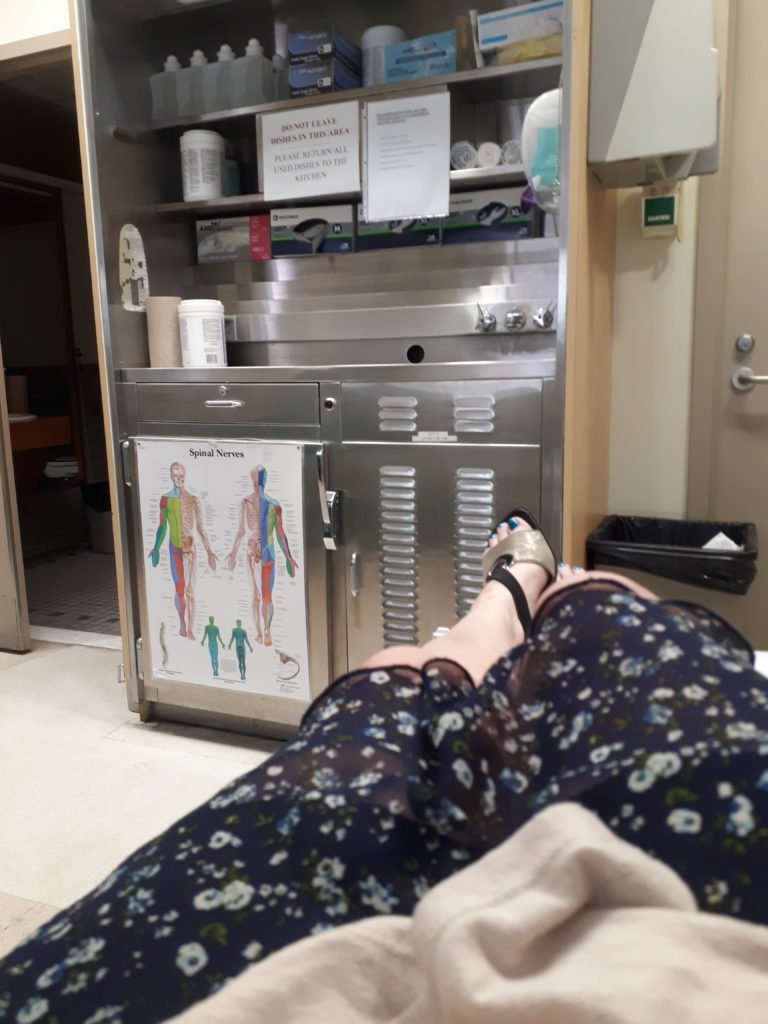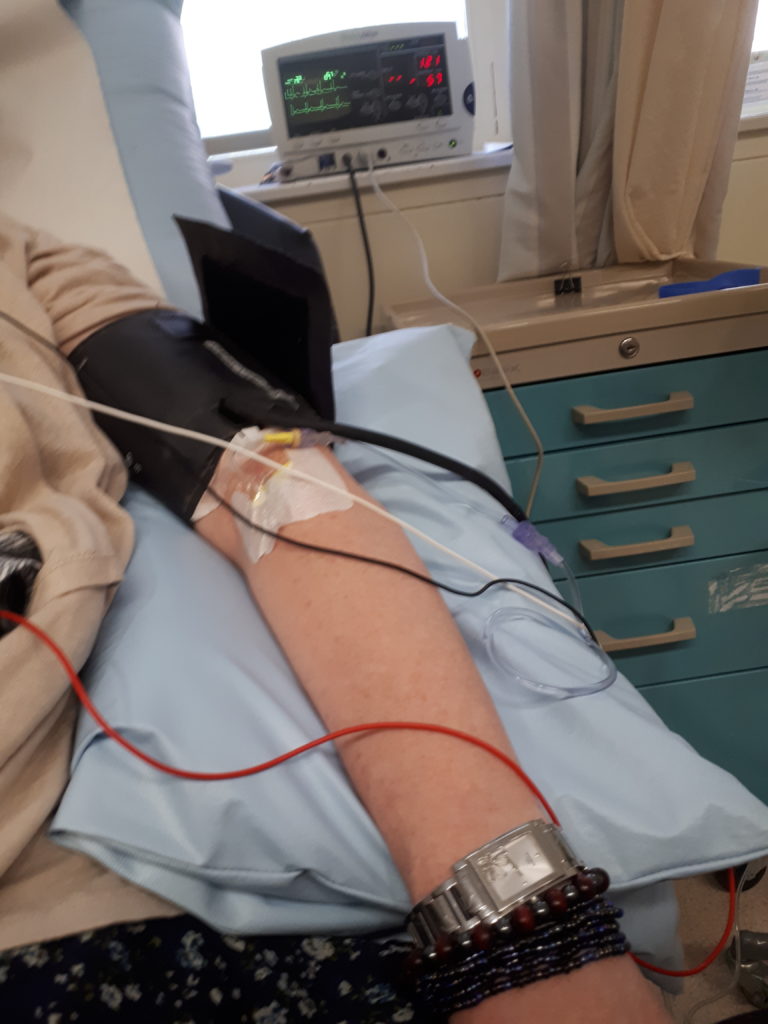I’d been looking forward to today, for almost a month. May 29th. The day I was going to have a new treatment at the hospital, for the rare neuro-inflammatory disease with which I’ve been struggling for over 2 years now.
Complex Regional Pain Syndrome, often still called Reflex Sympathetic Dystrophy or RSD, isn’t fatal or terminal. Technically it affects ‘only’ my right arm and hand, but in real life this disease impacts my entire life. The neuropathic pain and other problems affect everything I do. And the disease could start to spread again, any time, so that’s always in the back of my mind. Sadly, like so many other nasty illnesses, there’s no cure.
So a lot of what my medical care team does is trying to find ways to reduce all the ways this condition affects my daily life. And part of that is trying to reduce my pain levels. I’m lucky to be a patient at a specialized section of a large university hospital; a Pain Management Unit, or PMU. The team members there are familiar with my rare disease, and also – just as importantly, in many ways – they’re very kind.
My PMU team and I have tried a variety of ways to reduce pain, so last month I agreed to try something completely different. A full-body infusion of… a local anaesthetic. Which seems a bit strange, because local anaesthetics are used to numb (or nerve block) a specific area of the body. That’s why it’s called a “local” anaesthetic!
The anaesthetic the PMU wanted to try, for my infusion, is sometimes used to slow down a person’s heartbeat (as a cardiac depressant), so I had to have an electrocardiogram 2 hours before the infusion. That’s what’s usually called an ECG or an EKG in most hospitals – and on medical drama TV shows!
The easiest way to explain an infusion is that it’s kind of like when someone with cancer goes for chemotherapy; the patient sits in a chair – or in my case lies on a hospital bed – and a liquid is dripped into their vein(s) from an intravenous (IV) bag hanging from a stand beside them. Some of my loved ones have had chemotherapy treatments, and each of those usually last a few hours (which they say seems like days!).
The IV bag is already filled with a mix of mineral salts and water, called a saline solution. The medication is added to the IV bag, so it gets diluted in (mixed with) the saline solution. Instead of getting the medication all at once in an injection or pill, it goes into your body very slowly with an infusion.
My infusion was supposed to last between 1.5 to 2 hours. The idea was that the infusion of local anaesthetic could – somehow – affect my nerve pathways; that it could lower my levels of neuropathic pain. We hoped that that the full-body infusion would remove the pain temporarily, and that it wouldn’t come back as strong after the medication wore off.
No one knows how CRPS works, so we can only guess at how any treatment might work. My doctor, the Director of this PMU, had heard of full-body infusions with this local anaesthetic. He’d heard that there had been some good results, for a few patients with CRPS. With this disease, each treatment is like a 1-person experiment; it might or might not work on that 1 patient. That’s because ‘each patient presents differently” with CRPS. That means that each patient has different combinations of the many symptoms of CRPS.
So, about the infusion. I’d been told that I wouldn’t be able to drive after the treatment. That I’d probably feel dizzy, nauseated, and maybe even confused. I’d have to wait “under observation” for at least an hour before leaving the hospital, and then someone would have to take me home. To make sure that I wasn’t going to try to drive or take a bus by myself, the person taking me home had to come up to the PMU (on the 5th floor of the hospital) to get me. All those warnings left me feeling a bit nervous about the infusion.
Because I had to be there a few hours early, to have the ECG/EKG in another part of the hospital, I’d be in the building almost all day. I didn’t want my husband to miss that much time off work, just waiting around with me, so we agreed on a plan. I’d drive to the hospital, from my office, in the morning. And then he’d come to pick me up at the hospital after work.
Remember when I said the folks at the PMU are very kind? Here’s an example. The PMU had told me that I could wait there if my husband was stuck in traffic; that one of the doctors would be working late, so I could stay in the PMU’s reserved waiting room after the nurses and other staff left for the day.
Otherwise I would have had to wait for my husband in a regular “under observation” area/room at the hospital. The one at the PMU is much quieter and more comfortable than the other ones. The observation area at PMU even has a few special – super-comfy – chairs – reserved for patients who’ve just had an infusion. They recline a bit, and have a padded headrest built in, and wide arms; so you can take a nap right there, if you feel sleepy after your infusion.
My plan with my husband was to wait a few hours until I felt okay to drive my car home. If I felt well enough we’d go for a walk; the hospital’s right beside Mount Royal Park, a beautiful green space designed in the late 1800s by Frederick Law Olmstead. That’s the same man who created Central Park in New York City! And if I felt well enough, we’d go out for a light supper. I’d have been fasting all day by that point.
Our back-up plan, if I didn’t feel well, was to stay in the PMU observation area with my husband. The PMU team had told me that would be okay; my husband could read or something while I recovered, and they’d give him an emergency button in case I got worse.
Then, at least 4 hours after my infusion, we’d each drive home. My doctor had told me I should be able to drive after 4 hours.
So… what happened – How did the infusion go?

The ECG/EKG went much more quickly than I expected, because I didn’t have to wait at all. I’d never gone for a test in a different department/unit at this hospital, so I was surprised when I didn’t even had time to sit down! They called me in just a few seconds after I handed in my test request form. I’ll write a post later, about the fantastic ECG/EKG technician.
After the ECG/EKG I had about 2 hours ‘to kill’, so I went for a short walk outside the hospital. I was nervous about this new procedure, and walking calms me. But it was too hot to stay outside for very long. So I went upstairs to the PMU about an hour early for the infusion. I’d brought a book, so checked in with the PMU’s receptionists and then sat down to read.
My PMU doctor saw me in the waiting area, so came by to ask if I was being kept waiting. (If you know anything about Canadian healthcare systems, you’ll know that doesn’t happen often – particularly when the doctor is the Director of an entire unit at a hospital!!!). I told him I was more than an hour early because the ECG/EKG was done so quickly, so he went to see if the nurse could prepare my infusion earlier than planned ‘-)
The infusion itself went very well. My nurse was lovely, taking the time to chat with me while she put a catheter into my hand – the one not affected by CRPS. She explained the procedure to me again, to be sure I didn’t have any questions. She also put electrodes on my chest again, kind of like for the ECG/EKG, so they could see if I had any heart problems during the infusion.
My nurse made sure I was comfortable in the hospital bed, because she said I “might be there for a few hours”. She brought a blanket for my legs, and an extra pillow. She told me that some patients with chronic pain conditions (including cancer pain) have infusions every other week at the PMU, so they try to make them as comfortable as possible.
While my nurse and I were chatting, my husband texted me to ask if he could come sit with me – if he was able to leave work early. My nurse said that’d be fine; he could use her stool beside my hospital bed, and she’d sit at a desk. She said he could just ask the PMU receptionists to show him where the infusion room is, and then come right in; I was the only patient in the infusion room that afternoon.
I was very happy he’d be able to sit beside me, because I was still nervous. I give blood regularly, so I’m not afraid of needles. What was making me apprehensive was knowing the infusion could make me feel nauseated. I hate the feeling of vomiting, throwing up. That’s why I’d been fasting all day; another doctor had told me I’d be less likely to be sick if I hadn’t eaten. Makes sense, right?
Once the nurse had everything set up, my doctor came in. He explained to me – and my nurse – that because it was the first time I was having a full-body anaesthetic infusion, he was going to do something different. He didn’t inject the full dose of the liquid anaesthetic into my IV bag, to dilute in the saline solution. Instead, he started off by injecting a very small amount of the anaesthetic right into the catheter in my hand (a bolus) – so it went right into my vein, without being diluted in the IV bag liquid.
My doctor told me he wanted to be right beside me, when the anaesthetic first entered my vein, to be there to note any changes I might experience and in case I didn’t feel okay. I hadn’t met this nurse before, so I’d be with someone I knew. Again, that kindness. He could have gone back to his office, and waited for the nurse’s report. Instead, he stayed beside me for the first few minutes.

The only effect I felt at first was a very strange tingling on the inside of my lips, which my doctor said was an expected effect. He said I was trembling a bit, which explains why this selfie is kind of fuzzy!
After a few minutes, my doctor injected the rest of the dose into the IV bag. Just then my husband arrived, and my doctor went back to his office a few doors down the hallway.
Until my husband got there, I hadn’t realized how nervous I was about this new procedure. I was so happy to see him, and he was really happy that he’d gotten there at the very start of the infusion. After a few minutes more, the nurse went into another office and showed my husband how to ‘call’ her if I started to feel sick or needed anything.
The time passed so much more quickly because my husband was there. After about 15 minutes, the pain in my arm and hand was almost gone – so we were able to hold hands again – with my right hand – for the first time in over 2 years…
Overall the only effects I felt from the infusion were the tingling lips, and a reduction of my arm/hand pain to almost nothing. When you’ve been in high-level pain almost constantly (except during/after nerve blocks), for over 2 years, ‘almost pain free’ feels pretty good! There was no nausea, no dizziness, no confusion. I felt fine, but of course I still had to stay under observation at the hospital for at least an hour after the procedure.
Before I left, the nurse booked me for a follow-up call next week; she or another nurse will call me, at a scheduled time, to see how I’m doing after the infusion. The PMU did this so I wouldn’t have to go back to the hospital, just for a follow-up appointment.
They really try to find ways to make things easier for their patients ‘-) In the meantime, I’ll have to complete a pain diary, so that my doctor can see if – or when – my pain returns. I’m really hoping that it won’t!

